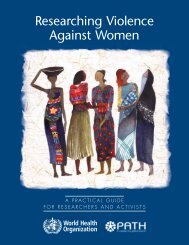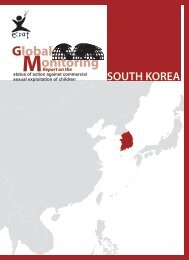2007 Trafficking in Persons Report - Center for Women Policy Studies
2007 Trafficking in Persons Report - Center for Women Policy Studies
2007 Trafficking in Persons Report - Center for Women Policy Studies
You also want an ePaper? Increase the reach of your titles
YUMPU automatically turns print PDFs into web optimized ePapers that Google loves.
Prevention<br />
The Cambodian government demonstrated modest<br />
ef<strong>for</strong>ts to prevent traffick<strong>in</strong>g. The M<strong>in</strong>istry of<br />
Interior’s Anti-<strong>Traffick<strong>in</strong>g</strong> Police Unit conducted<br />
education campaigns target<strong>in</strong>g school children<br />
about the risks of traffick<strong>in</strong>g and their rights.<br />
Dur<strong>in</strong>g 2006, the police campaign reached approximately<br />
20,000 students <strong>in</strong> Siem Reap and 3,000<br />
students <strong>in</strong> Phnom Penh. Work<strong>in</strong>g with NGOs<br />
and <strong>in</strong>ternational organizations, the government<br />
implemented a national public awareness campaign<br />
through posters, television, radio, and use of<br />
traditional Cambodian theater. Cambodia has not<br />
ratified the 2000 UN TIP Protocol.<br />
CAMEROON (Tier 2)<br />
Cameroon is a source, transit, and dest<strong>in</strong>ation<br />
country <strong>for</strong> women and children trafficked <strong>for</strong> the<br />
purposes of <strong>for</strong>ced labor and commercial sexual<br />
exploitation. Most victims are children trafficked<br />
with<strong>in</strong> the country, with girls trafficked <strong>for</strong> domestic<br />
servitude, to work as nannies, or <strong>for</strong> sexual exploitation.<br />
Both boys and girls are trafficked with<strong>in</strong><br />
Cameroon <strong>for</strong> <strong>for</strong>ced labor <strong>in</strong> sweatshops, bars,<br />
restaurants, and on tea plantations. Children are<br />
trafficked to Cameroon from Nigeria, Chad, the<br />
Central African Republic, Congo, Ben<strong>in</strong>, and Niger<br />
<strong>for</strong> <strong>for</strong>ced labor <strong>in</strong> agriculture, street vend<strong>in</strong>g and<br />
spare-parts shops. Cameroonian children are trafficked<br />
to Gabon and Equatorial Gu<strong>in</strong>ea <strong>for</strong> domestic<br />
servitude, and <strong>for</strong>ced market and agricultural labor.<br />
Cameroon is a transit country <strong>for</strong> children trafficked<br />
between Gabon and Nigeria, and from Nigeria to<br />
Saudi Arabia. Cameroonian women are sent by<br />
sex traffick<strong>in</strong>g r<strong>in</strong>gs to Europe, primarily France,<br />
Germany, and Switzerland. There are also reports<br />
that a religious leader <strong>in</strong> Cameroon’s Northern<br />
Prov<strong>in</strong>ce holds slaves with<strong>in</strong> his locked compound.<br />
The Government of Cameroon does not fully<br />
comply with the m<strong>in</strong>imum standards <strong>for</strong> the elim<strong>in</strong>ation<br />
of traffick<strong>in</strong>g; however, it is mak<strong>in</strong>g significant<br />
ef<strong>for</strong>ts to do so, despite limited resources. To<br />
strengthen its response to traffick<strong>in</strong>g, the government<br />
should pass its draft law prohibit<strong>in</strong>g traffick<strong>in</strong>g<br />
of adults, <strong>in</strong>crease its law en<strong>for</strong>cement ef<strong>for</strong>ts<br />
and develop a system <strong>for</strong> collect<strong>in</strong>g traffick<strong>in</strong>g crime<br />
data, <strong>in</strong>vestigate reports of slavery, strengthen ef<strong>for</strong>ts<br />
to rescue and care <strong>for</strong> victims, <strong>in</strong>crease traffick<strong>in</strong>g<br />
awareness-rais<strong>in</strong>g <strong>in</strong>itiatives, and adopt its draft<br />
national action plan to combat traffick<strong>in</strong>g.<br />
Prosecution<br />
The Government of Cameroon made weak law<br />
en<strong>for</strong>cement ef<strong>for</strong>ts to combat traffick<strong>in</strong>g dur<strong>in</strong>g the<br />
last year. Cameroon does not prohibit all <strong>for</strong>ms of<br />
traffick<strong>in</strong>g, though it crim<strong>in</strong>alizes child traffick<strong>in</strong>g<br />
and slavery through its 2005 anti-child traffick<strong>in</strong>g<br />
law, which prescribes a penalty of 20 years’ imprisonment<br />
— a punishment sufficiently str<strong>in</strong>gent and<br />
more severe than that <strong>for</strong> rape. The government<br />
cont<strong>in</strong>ued to draft a law prohibit<strong>in</strong>g traffick<strong>in</strong>g of<br />
adult women. In November 2006, police arrested<br />
n<strong>in</strong>e <strong>in</strong>dividuals <strong>for</strong> traffick<strong>in</strong>g 16 Nigerian children<br />
from Nigeria through Cameroon en route to Saudi<br />
Arabia. Accord<strong>in</strong>g to NGOs, the government may<br />
have prosecuted or convicted traffickers dur<strong>in</strong>g the<br />
year; however, it did not report this due to its lack<br />
of a crime data collection system. Eight traffickers<br />
whose cases have been pend<strong>in</strong>g s<strong>in</strong>ce 2005 are still<br />
await<strong>in</strong>g trial. The government does not provide<br />
traffick<strong>in</strong>g tra<strong>in</strong><strong>in</strong>g to law en<strong>for</strong>cement officials.<br />
Protection<br />
The Government of Cameroon demonstrated<br />
m<strong>in</strong>imal ef<strong>for</strong>ts to protect traffick<strong>in</strong>g victims over<br />
the last year. The government cont<strong>in</strong>ued operat<strong>in</strong>g<br />
temporary shelters <strong>in</strong> all 10 prov<strong>in</strong>cial capitals of<br />
the country. These shelters provided care to victims<br />
while officials located their families. The government<br />
also cont<strong>in</strong>ued to refer victims to NGOs and<br />
private orphanages <strong>for</strong> assistance. In 2006, the<br />
government began recruit<strong>in</strong>g 60 social workers<br />
it plans to tra<strong>in</strong> by 2008 to work <strong>in</strong> its traffick<strong>in</strong>g<br />
victim centers. In November 2006, police rescued<br />
16 Nigerian children be<strong>in</strong>g trafficked through<br />
Cameroon to Saudi Arabia, referred them to a<br />
Cameroonian NGO, and are conduct<strong>in</strong>g <strong>in</strong>vestigations<br />
to locate the children’s families <strong>in</strong> Nigeria.<br />
The government does not encourage victims, most<br />
of whom are children, to participate <strong>in</strong> <strong>in</strong>vestigations<br />
or prosecutions. Cameroon provides short<br />
term residency, a limited legal alternative to the<br />
removal of <strong>for</strong>eign victims to countries where they<br />
face hardship or retribution. Victims are not penalized<br />
<strong>for</strong> unlawful acts committed as a direct result<br />
of be<strong>in</strong>g trafficked.<br />
Prevention<br />
The Government of Cameroon made <strong>in</strong>sufficient<br />
ef<strong>for</strong>ts to raise awareness about traffick<strong>in</strong>g dur<strong>in</strong>g<br />
the report<strong>in</strong>g period. With NGOs and the ILO,<br />
the government <strong>in</strong> June 2006 jo<strong>in</strong>tly organized a<br />
conference, concert and exhibit commemorat<strong>in</strong>g<br />
the World Day Aga<strong>in</strong>st Child Labor. In September<br />
2006, the M<strong>in</strong>istry of Social Affairs launched a<br />
radio campaign on 18 stations throughout the<br />
country to educate the public about the dangers of<br />
child labor exploitation.<br />
C A M E R O O N<br />
75
















